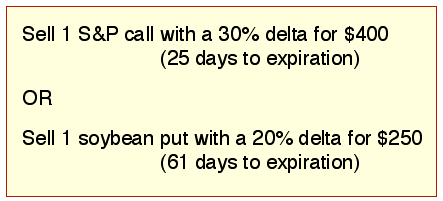A New Tool For Option Strike Comparisons
Compare Option Strikes With This
How do you compare options with different strikes, margin requirements, and expiration dates? Here's a tool that will help you make that decision.
More bang per buck: Many businessmen will tell you that there is no more important factor in financial decision-making. Option sellers face a specific version of this decision: How should limited margin dollars be allocated among possible trades to maximize return on investment? Figure 1 frames the question.
Is option trading an investment? Perhaps not; in several respects it
is a unique class of trading, because time decay, fluctuating margin requirements,
directional bias, and shifting gamma combine to pose some unique trading
questions. But because profits from option selling can be enhanced by the
passage of time, profit potential can be evaluated in terms of a rate of
return over time, just like an investment. All that is needed is a tool
that enables us to compare options with different strikes, margin requirements,
and expiration dates. Enter the Zurick quotient (ZQ).

FIGURE 1: WHICH OFFERS THE HIGHER POTENTIAL RETURN? Deciding whether to sell S&P calls or soybean puts means you have to consider several variables.
BREAKING DOWN THE ZQ
The first variable in the ZQ formula gives the overview: How much option premium can you collect, in dollars, per dollar of margin requirement? (Short options, like futures, entail theoretically unlimited risk and therefore require margin.) If you sell an option and it expires worthless, great. But what will it cost you to do so? Disregarding the risk, is the potential return on margin even remotely attractive?
The soybean versus S&P example in Figure 2 indicates a greater potential return for selling the bean options primarily due to much lower margin requirements. But other variables complicate the comparison of options on futures.
...Continued in the November issue of Technical Analysis of STOCKS
& COMMODITIES
Excerpted from an article originally published in the November 2007
issue of Technical Analysis of
STOCKS & COMMODITIES magazine. All rights reserved. © Copyright
2007, Technical Analysis, Inc.
Return to November 2007 Contents